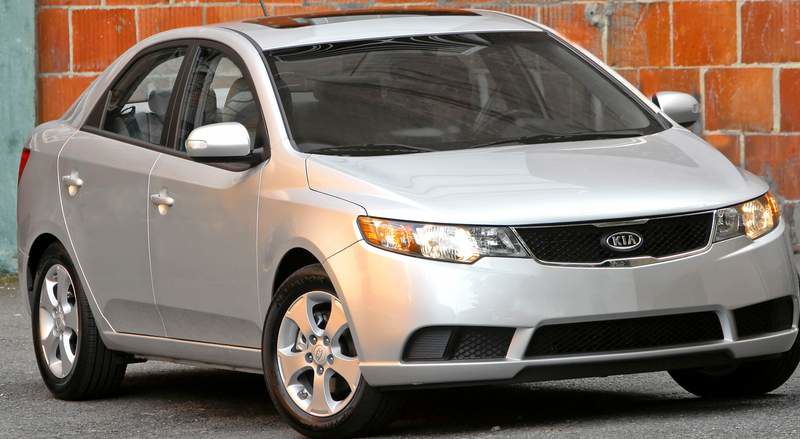The Wal-Mart of cars
Published 5:00 am Sunday, July 12, 2009

- The 2010 Kia Forte family sedan has excellent fit and finish, and its interior ergonomics were better than those found in many rival cars.
WASHINGTON — To understand the future of the automobile industry, you must understand the success of Wal-Mart, the world’s largest retail organization.
It is an achievement based on common sense. Wal-Mart consistently offers excellent quality at prices lower than those charged by the competition.
It is an attractive business model that draws consumers from all walks of life, especially in tough economic times. It matters not that Wal-Mart is a nonunion company with a blue-collar persona. Nor does it matter that you are a professional or a worker holding a union card. If you want the best for less, you shop there.
So here’s the deal: The car company that best follows the Wal-Mart example is the one that will own the future of the automobile industry.
Don’t be surprised if that company comes from South Korea.
Take a look at this week’s subject car, the 2010 Kia Forte family sedan, sold at base prices of $13,695 to $18,195. Those prices cover compact, front-wheel-drive automobiles built as well as anything from Chevrolet, Chrysler, Ford, Honda, Nissan or Toyota. South Korean automobile manufacturer Hyundai owns Kia. So Hyundai is included.
The kicker is that the Forte is priced lower — in many cases much lower — than the competition.
To say the least, I and my evaluation crew — my wife, Mary Anne, and my assistant for vehicle evaluations, Ria Manglapus — were shocked. In our minds, we had equated “cheap” with, well, cheap. But after putting nearly 500 miles on the Forte EX, which sits in the middle of the Forte line, we changed our stereotypical understanding of “cheap” to a more appropriate “inexpensive.” In this instance, that meant remarkable value.
Fit and finish on our Forte EX was excellent. Interior ergonomics — ease of sight and ease of use of gauges and controls — were better than those found in many rival cars. That’s “better” as in “better” as opposed to “better for the money.”
Some examples: Audio, heat and ventilation controls are clearly positioned and labeled, a welcome relief from cars in which the positioning and use of those controls have been turned into a dark science.
Also there’s this: In a driving emergency, such as a sudden stoppage of traffic, the caution signal button, indicated by a small red triangle within a larger red triangle, becomes the most important button on the instrument panel. You want to quickly push that button to alert motorists behind you that you are slowing down or stopping because of trouble ahead.
Too many car companies seem to go out of their way to conceal the caution signal button. Their stylists render the button practically invisible and less useful by shrinking its size and blending it within overall instrument panel.
Kia has taken the opposite approach in its Forte line. The caution signal button is the largest single control; and it sits at the top of the instrument panel. It is hard to miss and easy to reach and use. Thus Kia gives the caution signal button the supreme importance it has always deserved.
We disagreed on the feel of the Forte EX’s ride. Ria thought it was too hard, making it a tad uncomfortable for a family sedan. Mary Anne and I demurred. We thought the Forte EX’s stiffer-than-usual-ride for a compact sedan (probably because of its optional low-rolling resistance tires) contributed to the car’s better-than-usual handling for a compact family sedan.
We all marveled over the car’s zippy acceleration, delivered via the Forte EX’s 2-liter, 156-horsepower, inline four-cylinder engine. But we were more impressed with its fuel economy: 25 miles per gallon in the city and 34 mpg on the highway running on regular unleaded gasoline.
The Forte’s standard safety features, including four-wheel disc brakes and full-length head-curtain airbags, match those found in substantially more expensive cars. The same is true of the Forte’s optionally available amenities, such as iPod, BlueTooth phone and MP3 player connectivity.
The bottom line
Head-turning quotient: Passionately ordinary — its looks are easy to love, hate or ignore. It is available in six trim levels: base LX manual and LX automatic, mid-level EX manual and EX automatic, upscale SX manual and SX automatic.
Capacities: There are seats for five people. Maximum luggage capacity is 14.7 cubic feet. The fuel tank holds 13.7 gallons of regular unleaded gasoline.
Mileage: The car lived up to its federal mileage rating, even in traffic jams.
Safety: Standard equipment includes electronic stability and traction control, four-wheel disc brakes (ventilated front, solid rear) with antilock protection, side air bags for front-seat occupants, and front-to-rear head air bags.
Purse-strings note: This one is easy. It’s a buy.
2010 Kia Forte
Base price: $16,795
As tested: $19,890
Type: Compact, front-engine, front-wheel-drive family sedan with a traditional notchback trunk
Engine: 2-liter, 16-valve, inline four-cylinder, mated to a five-speed manual transmission
Mileage: 25 mpg city, 34 mpg highway






